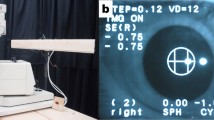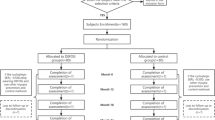Abstract
Background
To investigate the peripheral optical quality and its relationship with axial elongation, myopic progression in Japanese children.
Methods
Twenty-nine Japanese children, ages 10 to 12 years old, with baseline refraction from +0.75D to −5.5 D, were included and followed for 9 months. The central and peripheral point spread functions (PSFs; 0°, 10°, 20°, 30° nasally) were obtained at 0.25 D steps around ±2.5 D of best-focus PSF (BF-PSF) using double-pass PSF system. Modulation transfer function (MTF) area of the BF-PSF was calculated from BF-PSF to represent the peripheral optical quality. Relative peripheral defocus (RPD), the refraction of anterior/posterior focal lines, MTF area, and their correlations with myopia progression were analyzed.
Results
The average refractive change in 9 months was −0.5 ± 0.8 D. The change in axial length was significantly positively correlated with the amount of myopic progression (P = 0.0058) and RPD (P = 0.0007, 0.0036 and 0.0040, at 10°, 20°, 30° respectively) at the initial visit, but did not correlate with the peripheral MTF area. Myopic progression of more than 0.5 D with axial elongation was observed in seven children (MP group). The RPDs at 20° and 30° in the MP group were significantly more hyperopic than in the non-MP group (P = 0.002 and 0.007), whereas there was no significant difference in axial length, and central and peripheral MTF area between the MP and non-MP groups. MP group had more hyperopic focal lines compared with non-MP group at 20°and 30°.
Conclusion
These results suggest that the progression of axial myopia in children is associated with hyperopic RPD and refraction of focal lines, not with peripheral optical quality.






Similar content being viewed by others
References
Wong TY, Foster PJ, Hee J, Ng TP, Tielsch JM, Chew SJ, Johnson GJ, Seah SK (2000) Prevalence and risk factors for refractive errors in adult Chinese in Singapore. Invest Ophthalmol Vis Sci 41:2486–2494
Pan CW, Wong TY, Lavanya R, Wu RY, Zheng YF, Lin XY, Mitchell P, Aung T, Saw SM (2011) Prevalence and risk factors for refractive errors in Indians: the Singapore Indian Eye Study (SINDI). Invest Ophthalmol Vis Sci 52:3166–3173
Saw SM, Chan YH, Wong WL, Shankar A, Sandar M, Aung T, Tan DT, Mitchell P, Wong TY (2008) Prevalence and risk factors for refractive errors in the Singapore Malay Eye Survey. Ophthalmology 115:1713–1719
Holekamp NM, Harocopos GJ, Shui YB, Beebe DC (2008) Myopia and axial length contribute to vitreous liquefaction and nuclear cataract. Arch Ophthalmol 126:744, author reply 744
Kuzin AA, Varma R, Reddy HS, Torres M, Azen SP (2010) Ocular biometry and open-angle glaucoma: the Los Angeles Latino Eye Study. Ophthalmology 117:1713–1719
Li X (2003) Incidence and epidemiological characteristics of rhegmatogenous retinal detachment in Beijing, China. Ophthalmology 110:2413–2417
Hsiang HW, Ohno-Matsui K, Shimada N, Hayashi K, Moriyama M, Yoshida T, Tokoro T, Mochizuki M (2008) Clinical characteristics of posterior staphyloma in eyes with pathologic myopia. Am J Ophthalmol 146:102–110
Charman WN (2011) Keeping the world in focus: how might this be achieved? Optom Vis Sci 88:373–376
Ip JM, Saw SM, Rose KA, Morgan IG, Kifley A, Wang JJ, Mitchell P (2008) Role of near work in myopia: findings in a sample of Australian school children. Invest Ophthalmol Vis Sci 49:2903–2910
Woodman EC, Read SA, Collins MJ, Hegarty KJ, Priddle SB, Smith JM, Perro JV (2011) Axial elongation following prolonged near work in myopes and emmetropes. Br J Ophthalmol 95:652–656
Siegwart JT Jr, Norton TT (2011) Perspective: how might emmetropization and genetic factors produce myopia in normal eyes? Optom Vis Sci 88:E365–E372
Smith EL 3rd, Hung LF (2000) Form-deprivation myopia in monkeys is a graded phenomenon. Vision Res 40:371–381
Wallman J, Winawer J (2004) Homeostasis of eye growth and the question of myopia. Neuron 43:447–468
Mutti DO, Sholtz RI, Friedman NE, Zadnik K (2000) Peripheral refraction and ocular shape in children. Invest Ophthalmol Vis Sci 41:1022–1030
Sankaridurg P, Holden B, Smith E 3rd, Naduvilath T, Chen X, Jara PL, Martinez A, Kwan J, Ho A, Frick K, Ge J (2011) Decrease in rate of myopia progression with a contact lens designed to reduce relative peripheral hyperopia: one-year results. Invest Ophthalmol Vis Sci 52:9362–6367
Mutti DO, Hayes JR, Mitchell GL, Jones LA, Moeschberger ML, Cotter SA, Kleinstein RN, Manny RE, Twelker JD, Zadnik K (2007) Refractive error, axial length, and relative peripheral refractive error before and after the onset of myopia. Invest Ophthalmol Vis Sci 48:2510–2519
Mutti DO, Sinnott LT, Mitchell GL, Jones-Jordan LA, Moeschberger ML, Cotter SA, Kleinstein RN, Manny RE, Twelker JD, Zadnik K (2011) Relative peripheral refractive error and the risk of onset and progression of myopia in children. Invest Ophthalmol Vis Sci 52:199–205
Kang P, Swarbrick H (2011) Peripheral refraction in myopic children wearing orthokeratology and gas-permeable lenses. Optom Vis Sci 88:476–482
Kakita T, Hiraoka T, Oshika T (2011) Influence of overnight orthokeratology on axial elongation in childhood myopia. Invest Ophthalmol Vis Sci 52:2170–2174
Artal P, Derrington AM, Colombo E (1995) Refraction, aliasing, and the absence of motion reversals in peripheral vision. Vision Res 35:939–947
Lundstrom L, Mira-Agudelo A, Artal P (2009) Peripheral optical errors and their change with accommodation differ between emmetropic and myopic eyes. J Vis 9(17):11–11
Mathur A, Atchison DA, Charman WN (2009) Myopia and peripheral ocular aberrations. J Vis 9(15):11–12
Negishi K, Kobayashi K, Ohnuma K, Ohno K, Noda T (2006) Evaluation of optical function using a new point spread function analysis system in cataractous and pseudophakic eyes: preliminary results. Jpn J Ophthalmol 50:12–19
Kobayashi K, Shibutani M, Takeuchi G, Ohnuma K, Miyake Y, Negishi K, Ohno K, Noda T (2004) Calculation of ocular single-pass modulation transfer function and retinal image simulation from measurements of the polarized double-pass ocular point spread function. J Biomed Opt 9:154–161
Hung LF, Crawford ML, Smith EL (1995) Spectacle lenses alter eye growth and the refractive status of young monkeys. Nat Med 1:761–765
Smith EL 3rd, Hung LF, Kee CS, Qiao Y (2002) Effects of brief periods of unrestricted vision on the development of form-deprivation myopia in monkeys. Invest Ophthalmol Vis Sci 43:291–299
Donovan L, Sankaridurg P, Ho A, Naduvilath T, Smith EL 3rd, Holden BA (2012) Myopia progression rates in urban children wearing single-vision spectacles. Optom Vis Sci 89:27–32
Smith EL 3rd, Hung LF, Huang J, Blasdel TL, Humbird TL, Bockhorst KH (2010) Effects of optical defocus on refractive development in monkeys: evidence for local, regionally selective mechanisms. Invest Ophthalmol Vis Sci 51:3864–3873
Fan DS, Rao SK, Yu CB, Wong CY, Lam DS (2006) Changes in refraction and ocular dimensions after cataract surgery and primary intraocular lens implantation in infants. J Cataract Refract Surg 32:1104–1108
Inatomi M, Kora Y, Kinohira Y, Yaguchi S (2004) Long-term follow-up of eye growth in pediatric patients after unilateral cataract surgery with intraocular lens implantation. J AAPOS 8:50–55
Mathur A, Atchison DA (2010) Influence of spherical intraocular lens implantation and conventional laser in situ keratomileusis on peripheral ocular aberrations. J Cataract Refract Surg 36:1127–1134
Rahi JS, Cumberland PM, Peckham CS (2011) Myopia over the lifecourse: prevalence and early life influences in the 1958 British birth cohort. Ophthalmology 118:797–804
Artal P, Iglesias I, Lopez-Gil N, Green DG (1995) Double-pass measurements of the retinal-image quality with unequal entrance and exit pupil sizes and the reversibility of the eye’s optical system. J Opt Soc Am A Opt Image Sci Vis 12:2358–2366
Guirao A, Artal P (1999) Off-axis monochromatic aberrations estimated from double pass measurements in the human eye. Vision Res 39:207–217
Dubbelman M, Sicam VA, van der Heijde RG (2007) The contribution of the posterior surface to the coma aberration of the human cornea. J Vis 7(10):11–18
Artal P, Marcos S, Navarro R, Williams DR (1995) Odd aberrations and double-pass measurements of retinal image quality. J Opt Soc Am A Opt Image Sci Vis 12:195–201
Acknowledgments
This study was supported by a grant from the Japan Society for the Promotion of Science (No. 22791697). We thank Toru Noda for the advice and supports. We thank Deshea Harris for editing and correcting English of the manuscript. We thank Chiyo Kodama and Maki Akita for technical assistance.
Author information
Authors and Affiliations
Corresponding author
Additional information
The sponsor or funding organization had no role in the design or conduct of this research. No conflicting relationship exists for any author.
Financial support
Ministry of Education, Culture, Sports, Science and Technology: Grants-in-Aid for Scientific Research 20791274 (TY).
Rights and permissions
About this article
Cite this article
Yamaguchi, T., Ohnuma, K., Konomi, K. et al. Peripheral optical quality and myopia progression in children. Graefes Arch Clin Exp Ophthalmol 251, 2451–2461 (2013). https://doi.org/10.1007/s00417-013-2398-0
Received:
Revised:
Accepted:
Published:
Issue Date:
DOI: https://doi.org/10.1007/s00417-013-2398-0




